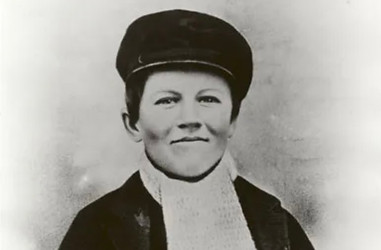
“But the man whose clothes were always wrinkled, whose hair was always tousled and who frequently lacked a shave probably did more than any other one man to influence the industrial civilization in which we live. To him we owe the phonograph and motion picture, the universal electric motor and the nickel-iron-alkaline storage battery, the fluorescent lamp, and the incandescent lamp – the germ from which sprouted the great power utility systems of our day. The number of patents far exceeds that of any other inventor. Once, asked in what his interests lay, Edison smilingly responded, ‘Everything.’”
Download the Full Thomas Edison Biography
Get the complete story of Edison’s life and inventions, written by John Venable.
Family and Early Life
In Ontario, Edison’s father, another Samuel, met and married Nancy Elliott, schoolteacher and daughter of a minister whose family had originally come from Connecticut. The brick cottage in which Thomas Alva Edison was born on February 11, 1847, still stands in Milan, Ohio. Edison’s formal schooling was of short duration, and his mother undertook the task of his education herself. Later in life, Edison married and raised six children, building a family that carried his legacy forward.

Thomas Edison at age 14, working on the Grand Trunk Railway

Edison after spending 48 hours perfecting the phonograph
Major Inventions
To him we owe the phonograph and motion picture, the universal electric motor and the nickel-iron-alkaline storage battery. The carbon telephone transmitter which made the telephone commercially practical was invented by Edison in 1877, the same year he gave the world the phonograph. Of 1,097 United States patents granted to Edison during his lifetime – by far the greatest number ever granted to one individual – 356 dealt with electric lighting and the distribution of electricity.
Menlo Park & the Light Bulb
With his success as an inventor and manufacturer at twenty-three, Edison plunged into a period of feverish endeavor. Few were his working days that did not extend through twenty of the twenty-four hours. In 1876 he established laboratories at Menlo Park, New Jersey. One of the greatest of the many “firsts” attributed to Edison is the carrying out of research on an organized basis, making possible his most acclaimed invention, the incandescent electric lamp.

Edison and his assistants in Menlo Park, 1880

Thomas Edison inspecting a roll of motion picture film
The West Orange Years
Edison entered into the fullest phase of his career when, at age of forty, he moved to his great new laboratory at West Orange, New Jersey, in 1887. During the first years he took out more than eighty patents on improvements on the phonograph and began experiments with motion pictures. On Oct. 6, 1889, his laboratory projected an experimental motion picture accompanied by synchronized sound. Edison also developed the fluoroscope and produced the alkaline storage battery.
Edison's Legacy
On Oct. 20, 1928, he was awarded the Congressional Medal of Honor – the nation’s highest award in recognition of services rendered. A year later, on the 50th anniversary of the incandescent lamp, the world paid homage in ceremonies with President Herbert Hoover, Henry Ford, and Albert Einstein. At 80 he launched another experiment, producing rubber from goldenrod grown in his gardens. Edison died peacefully at his home, Glenmont, in West Orange, on Oct. 18, 1931.
Ready to dive deeper into Edison’s story?

Thomas Edison receiving Congressional Medal of honor from Andrew Mellon.